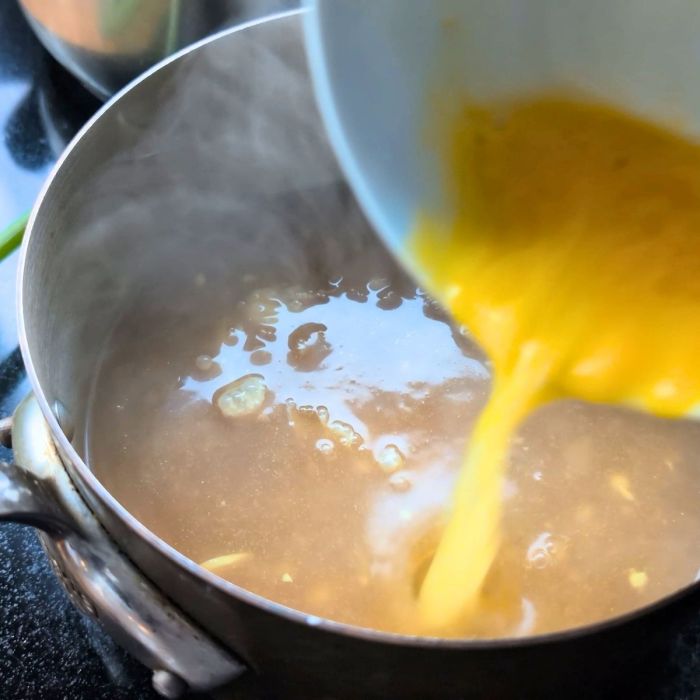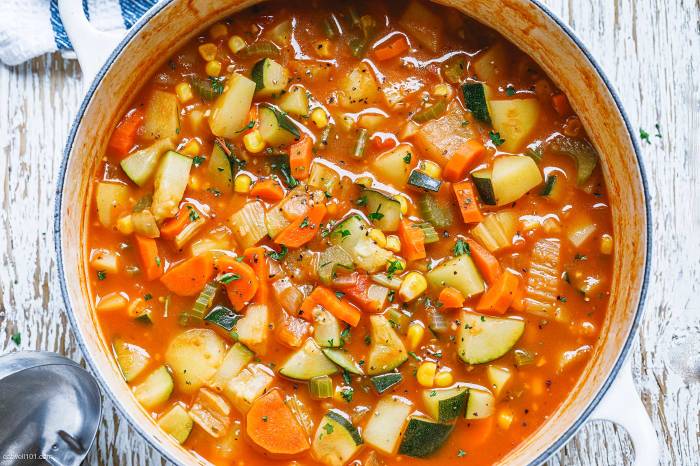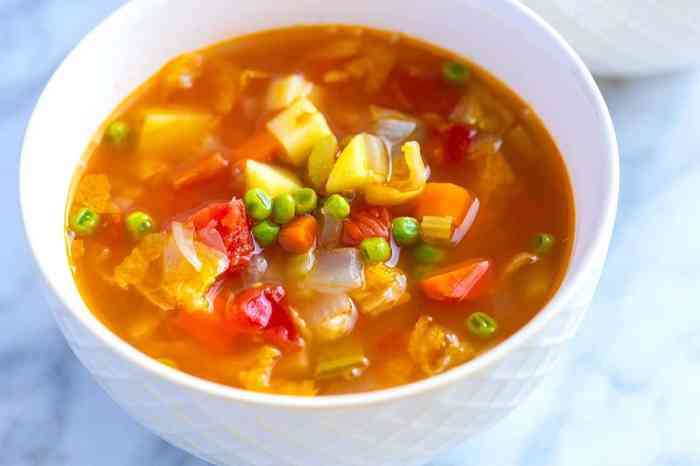Low-Sodium Vegetable Soup Recipes: A Guide to Flavorful and Healthy Cooking
Low sodium vegetable soup recipe – This guide explores the art of creating delicious and healthy low-sodium vegetable soups. We’ll delve into recipe variations, ingredient selection, cooking techniques, serving suggestions, and nutritional benefits, empowering you to create flavorful and heart-healthy meals.
Recipe Variations
Several variations of low-sodium vegetable soup cater to different tastes and dietary preferences. The following table showcases three distinct options, each featuring unique vegetable combinations.
| Name | Key Ingredients | Special Features | Serving Suggestion |
|---|---|---|---|
| Mediterranean Medley | Tomatoes, zucchini, eggplant, bell peppers, Kalamata olives, oregano | Bright, fresh flavors; herbaceous notes | Serve with crusty bread for dipping. |
| Hearty Root Vegetable | Carrots, potatoes, parsnips, celery root, thyme | Earthy and comforting; naturally sweet | Pair with a side salad for a balanced meal. |
| Asian-Inspired Vegetable | Bok choy, mushrooms, snow peas, ginger, soy sauce (low-sodium), sesame oil | Savory and umami-rich; slightly spicy | Garnish with chopped green onions and sesame seeds. |
A creamy low-sodium vegetable soup can be achieved using coconut milk instead of traditional cream. This provides a rich texture without the added sodium.
Creamy Coconut Vegetable Soup: Sauté diced onions, carrots, and celery in a little olive oil until softened. Add low-sodium vegetable broth, diced potatoes, and your choice of vegetables (e.g., spinach, mushrooms). Simmer until vegetables are tender. Stir in full-fat coconut milk and season with herbs like thyme or basil. Avoid adding salt; the coconut milk provides richness and depth of flavor.
A vegan low-sodium vegetable soup offers a hearty and flavorful option. The absence of dairy products allows for a clean taste profile that highlights the natural sweetness of the vegetables. Focusing on umami-rich ingredients like mushrooms and using a vegetable broth base can create a depth of flavor without relying on salt.
Ingredient Selection and Substitution
Careful ingredient selection is crucial for maintaining a low-sodium profile. Using low-sodium broth and canned vegetables is essential. Always check food labels for sodium content; aim for less than 140mg per serving.
Common high-sodium ingredients include regular canned soups, bouillon cubes, and soy sauce. Substitute these with low-sodium alternatives like homemade broth, herbs, and low-sodium soy sauce or tamari.
Naturally low-sodium vegetables that add significant flavor include:
- Mushrooms
- Zucchini
- Bell peppers
- Celery
- Onions
Cooking Methods and Techniques, Low sodium vegetable soup recipe

Source: lowsorecipes.com
Stovetop and slow cooker methods offer distinct advantages and disadvantages. Stovetop cooking provides more control over the cooking process and allows for quick adjustments to consistency and flavor. However, it requires more attention. Slow cooker methods are convenient and require minimal supervision, but can result in a less vibrant vegetable color.
Sautéing vegetables before adding them to the soup enhances their flavor. Heat olive oil in a pan over medium heat. Add vegetables and cook until slightly softened, stirring frequently to prevent burning. This process concentrates the natural sweetness and flavor of the vegetables without needing salt.
To maintain vibrant color and nutritional value, avoid overcooking. Add vegetables towards the end of the cooking process, ensuring they are tender-crisp. Steaming or blanching vegetables before adding them to the soup can help retain their color and nutrients.
Serving Suggestions and Enhancements

Source: eatwell101.com
Low-sodium vegetable soup pairs well with various accompaniments and flavor enhancers.
Serving suggestions:
- Serve with crusty bread for dipping.
- Pair with a side salad for a complete meal.
- Top with a dollop of plain yogurt or coconut cream (for non-vegan).
- Add grilled chicken or fish for extra protein (non-vegan).
- Enjoy it as a light lunch or starter.
Flavor enhancements:
- Fresh herbs like basil, oregano, thyme, and parsley add depth and complexity.
- Spices like black pepper, garlic powder, and onion powder provide subtle yet impactful flavor.
- A squeeze of lemon or lime juice adds brightness and acidity.
A visually appealing presentation enhances the dining experience. Serve the soup in a rustic bowl, garnished with fresh herbs (such as a sprig of parsley or a few chopped chives), a swirl of coconut cream (for non-vegan options), and a sprinkle of freshly cracked black pepper. The contrasting colors and textures create a visually enticing presentation.
Nutritional Information and Benefits

Source: inspiredtaste.net
Low-sodium vegetable soup offers significant nutritional benefits, particularly for heart health. Reducing sodium intake lowers blood pressure, reducing the risk of heart disease and stroke. The high fiber content aids digestion and promotes satiety. The abundance of vitamins and minerals contributes to overall well-being.
| Nutrient | Amount per serving | % Daily Value | Notes |
|---|---|---|---|
| Calories | 150 | 7.5% | Approximate, varies based on ingredients |
| Fiber | 5g | 20% | Promotes digestive health |
| Vitamin A | 150mcg | 16.7% | Supports vision and immune function |
| Vitamin C | 20mg | 22.2% | Acts as an antioxidant |
| Potassium | 300mg | 8.6% | Essential for muscle function |
Key vitamins and minerals and their health benefits:
- Vitamin A (from carrots, sweet potatoes): Supports vision, immune function, and cell growth.
- Vitamin C (from bell peppers, tomatoes): Acts as an antioxidant, boosting the immune system and protecting against cell damage.
- Potassium (from potatoes, tomatoes): Regulates fluid balance, blood pressure, and muscle contractions.
- Fiber (from various vegetables): Promotes digestive health, regulates blood sugar, and aids in weight management.
FAQ Insights: Low Sodium Vegetable Soup Recipe
Can I freeze this soup?
Yes, this soup freezes well. Allow it to cool completely before storing in airtight containers for up to three months.
How long can I store leftover soup in the refrigerator?
Leftover soup can be stored in the refrigerator for up to four days.
Can I use frozen vegetables?
Yes, frozen vegetables work well. Just be sure to add them towards the end of the cooking time to prevent overcooking.
What if I don’t have coconut milk for the creamy version?
Looking for a healthy, low-sodium vegetable soup recipe? A great way to reduce sodium is to focus on fresh ingredients and homemade broths. For a heartier option, consider incorporating pulses; you might find inspiration from a recipe like this lentil soup recipe chicken , adapting it to lower sodium by omitting or reducing added salt. Remember, even low-sodium options can benefit from careful seasoning with herbs and spices.
You can substitute with full-fat low-sodium milk or unsweetened almond milk for a creamy texture.
Can I adjust the spice levels?
Absolutely! Adjust the amount of herbs and spices to your preference. Start with a small amount and add more as needed.
